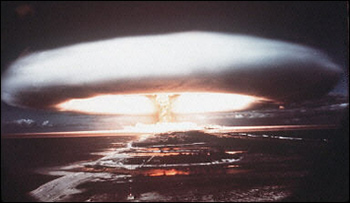Entered into the database on Friday, July 15th, 2005 @ 16:22:13 MST
Sixty years after the first atomic bomb was tested in the New Mexico desert, the
United States still has some 2,000 nuclear weapons on hair trigger alert and is
considering new weapons such as earth-penetrating bunker busters. The US administration has agreed to pare back its nuclear arsenal from about 10,000
warheads today to about 6,000 in 2012 under the Moscow Treaty reached with Russia
in 2001. But even as it moves to retire much of its Cold War arsenal, it has pressed
a reluctant Congress for funds for nuclear bunker-buster studies, refurbished
nuclear testing facilities, and a facility to build the plutonium triggers for
new weapons. The US Strategic Command in Omaha, Nebraska, is reported to be developing "global
strike" options, including a nuclear option, against potential adversaries
with nuclear weapons such as Iran and North Korea. More than 15 years after the fall of the Berlin Wall, nuclear weapons "are
alive and well," said Robert S. Norris, an expert at the Natural
Resources Defense Council, an arms control and environmental advocacy group. Norris points to the administration's Nuclear Posture Review of 2001 as "the
revealing document" that shows its intention to use nuclear weapons to
counter a new cast of potential adversaries armed with weapons of mass destruction. The review called for a "new triad" in which conventional and nuclear
forces would be meshed in a "global strike" capability, enabling the
United States to respond to a threat anywhere in the world on very short notice. It envisioned more precise long-range missiles armed with conventional warheads
as well as smaller, lower yield nuclear tips. The other parts of the triad are missile defense systems and a revived infrastructure
of weapons labs and production facilities that had deteriorated since the end
of the Cold War. "So the vision of the Bush administration is that we are going to need
nuclear weapons well out into the middle of the 21st century, and beyond. I
mean for decades to come," said Norris. But the administration appears not to have counted on Representative David
Hobson. The Ohio Republican, chairman of the House Appropriations subcommittee that
oversees the Energy Department's nuclear weapons programs, stunned the administration
by rejecting last year's request for new nuclear weapons funding. He nixed nine million dollars in funding for research into new low yield "mini-nukes;"
denied another 27.6 million dollars request for study of a Robust Nuclear Earth-Penetrating
Weapon; and put off a request for another 30 million dollars for a new plant
to manufacture the plutonium pits that trigger nuclear explosions. "The development of new weapons for ill-defined future requirements is
not what the nation needs at this time," Hobson said in a speech February
3 to the Arms Control Association. "What is needed, and what is absent to date, is leadership and fresh thinking
for the 21st Century regarding nuclear security and the future of the US stockpile,"
he said. The United States currently has 5,300 operational nuclear warheads, and another
5,300 in reserve, said Victoria Sampson, an expert at the Center for Defense
Information. "We have about 2,000 which are on hair trigger alert, which means they
can be ready to go within minutes of that decision to launch," she said. Hobson and others are worried that new nuclear weapons initiatives could lower
the threshold for their use, and warned it would send the wrong signal at a
time when the United States was demanding that North Korea and Iran stop their
weapons programs. But the administration has struck back with a request for 8.5 million dollars
of renewed funding for the nuclear earth penetrator in 2006. It also has asked for 25 million dollars to get its Nevada test site ready
to resume testing in 18 months if needed, instead of the 24 to 36 months it
would currently take. Those requests are working their way through Congress
where opposition remains strong. Defense Secretary Donald Rumsfeld argued that only "very large, very dirty
nuclear bombs" could now destroy the increasing numbers of facilities that
potential adversaries have buried deep underground. "So the choice is: do we want to have nothing and only a large, dirty
nuclear weapon, or would we rather have something in between. That is the issue,"
he said in April. "It seems to me studying it makes all the sense in the world," he
said. But scientists warn that no earth-penetrating nuclear weapon could bore deep
enough to trap devastating fallout that the National Academy of Sciences has
concluded would still kill more than a million people on the surface if it was
near a densely populated urban area.
A nuclear cloud. Sixty years after the first atomic
bomb was tested in the New Mexico desert, the United States still has some 2,000
nuclear weapons on hair trigger alert and is considering new weapons such as
earth-penetrating bunker